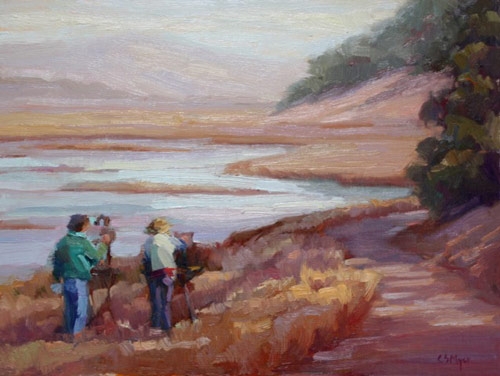It’s called Rush Creek, but it’s more of a wetlands area, with an estimated 196 species of birds enjoying the nature preserve’s 522 acres and adjacent marshland. And it’s Carol Smith Myer’s favorite place to paint.
Myer says Rush Creek, in California’s Marin County, has it all. “It’s nice that there’s water, and a clear foreground, background, and middle ground,” she says. “It’s a long walk to my favorite spot at Rush Creek, but when you get there, there it is — value, contrast, color, atmosphere.”

Myer’s setup on location at Rush Creek, in California’s Marin County
Marin County may bring to mind views of the Golden Gate Bridge and redwood forests, but Myer’s stomping grounds are at the northern end of this prized portion of the West Coast. Her painting spot is on a walking path, well used but far from facilities. She has painted there about five times, but also goes there to walk. “With a friend or daughter, I walk, but given the choice, I would always prefer to paint,” she says.

“Rush Creek,” by Carol Smith Myer, oil, 9 x 12 in.
Myer likes to place figures in the scene, and she may sketch them quickly on location and develop them a bit more in the studio. In the case of “Rush Creek Painters,” she could finish the piece on site. “It’s easy to paint painters because they are fairly stable,” she points out. The artist likes to paint at Rush Creek in mornings, when the light is interesting and the shadows rake across the path.

“Scout,” by Carol Smith Myer, 2012, oil, 12 x 9 in.
Myer likes to pick up on the subtle color differences created by weather and hour of day, and it’s not surprising that she is an admirer of Henry Hensche, the influential painter and educator who was based in Provincetown, Massachusetts. She has absorbed much of her ideas about color from Hensche via Camille Przewodek, a student of Hensche and a noted colorist who lives in nearby Petaluma, California.

“Mini Scout,” by Carol Smith Myer, 2013, oil, 6 x 6 in.
“Most of my paintings are about the color,” says Myer. “I do exaggerate the color a little bit. I try to catch whatever color the light is at that moment. Sometimes the light is more yellow, or orange, or pink. On cloudy days, it’s cooler. My successful paintings are the ones that express that particular time and weather.” Myer says she is interested in how the colors change — relatively so — from cloudy moments to sunny times. “On cloudy days, the shadows are warmer and the lights are cooler,” she says. “When the sun is out, the shadows are cooler. But it’s all relative.”

“Rush Creek Toddler,” by Carol Smith Myer, 2013, oil, 12 x 16 in.
This sensitivity to the color of light helps create a subtle mood. This careful expression of the experience can make the painting quite appealing to a viewer. It also keeps Myer’s pieces close to her own heart. “I can look at all the plein air paintings from different areas and remember what I felt like in that place and time,” says Myer. “They are memories.”

A Myer painting that demonstrates how shadows are cool and the sky is warm on sunny days
Myer says she used to get out to paint en plein air three or four days a week, but now it’s more like once a week. She has commissions and teaching that fill much of her time now. “I like to paint from life best of all, but with portrait commissions, I have to work from photographs. I like mixing it up — I do portraits, still lifes, figures.”

A Myer painting that shows how shadows are warmer and the sky cooler on overcast days
When she does have time to go outdoors and paint, she usually doesn’t have to worry about Mother Nature not cooperating. “We have beautiful weather here almost every day, fortunately,” Myer says.




